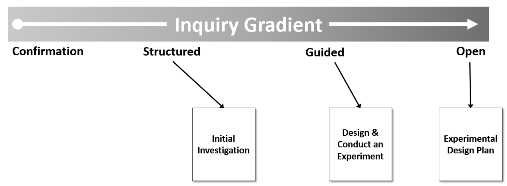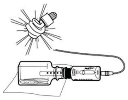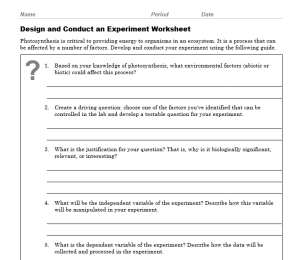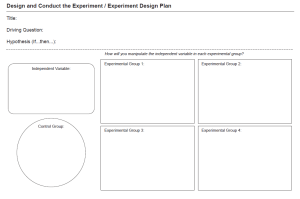Photosynthesis Inquiry
To help develop your students experimental design and scientific process skills the labs in the Advanced Biology Through Inquiry manual have 3 different approaches to the lab the can be varied or combined to challenge your students according to their ability. These approaches fall along the inquiry gradient as shown below. The photosynthesis lab is a great place to start your students on inquiry given the low material requirements, easy manipulations, and short data collection times.

The initial investigation takes a fairly traditional approach that asks students to collect a few runs of data and familiarizes them with the basic procedure for the lab. In this case, students are asked to complete two runs with different color light sources and compare their results. The setup is fairly simple and students should be able to complete the lab in a 45 min period. The initial investigation can provide a springboard for students who want to take a basic procedure and modify it to answer a question of their choosing. The procedure has been tested to provide significant results and helps students start thinking about photosynthetic processes and variables that can be investigated.

Following the initial investigation there are guided and open inquiry worksheets to help students organize their thoughts and make assessment easier. The first is a guided inquiry activity that leads students through the experimental design process with questions and the second is an experimental design plan. Students using the design and conduct an experiment guide are asked to choose a variable to manipulate, explain their data collection process, and detail data processing and analysis. This worksheet guides students through the experimental design process and ensures the students are well prepared to conduct their own investigation. For students that are familiar with the equipment through experience or a teacher demo, this may be the entry point to the inquiry lab. Students should be able to design and execute their lab in 1-2 lab periods depending on their design. One of the advantages of using probeware is that students can "fail faster" and quickly iterate their experimental design to improve the accuracy of their approach or better answer their driving question.

The questions in the guide are similar across each experiment and as students become familiar with the components of a well designed experiment they can progress to the experimental design plan. The experimental design plan is an organizer to help the students and allow for quick validation from a teacher.

In this plan students should identify their variables and trial groups but are no longer given guiding questions. Once again, this organizer can be provided to students immediately following the initial investigation or if students are ready at the start of a lab exercise. To view the complete procedure and see sample data for several inquiry experiments please download the sample file.
This lab is from PASCO’s new Advanced Biology Through Inquiry manual and is available for download with teacher notes.




